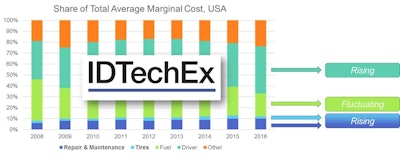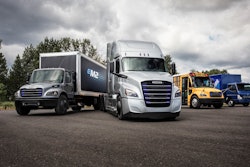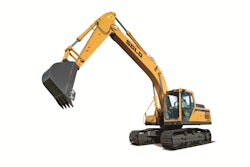Technology improvement with electrified road vehicles has been slow. The primary reason why trucks are now a major focus for electrification is local and national government and other regulations and incentives in the face of increasing public concern about road vehicle emissions and global warming. The brand new IDTechEx Research report Electric Trucks and Delivery Vans 2018-2028 finds the market for electric trucks and vans will reach $480bn by 2028.
Most trucks run on diesel and the ongoing announcements by certain countries and cities that they will ban diesel from a certain date in the future causes increasing uncertainty and risk for those making and using conventional trucks, including possible collapse in resale values. 
The trucking industry runs on tight margins and total cost of ownership is key, so fleet management companies delay purchases so they comply with new toughening carbon dioxide emissions laws — but the days of reckoning are now approaching. In 2018, the German government announced it will drop the tolls for electric semi trucks as of January 1, 2019. The move by transport minister Andreas Scheuer is designed to motivate the slow electrification of truck transport as it promises savings for haulage firms.
Larger and larger vehicles will become affordable in pure electric form due to battery and other costs reducing and ICE costs increasing due to extra emission control devices being fitted to meet more onerous emissions laws. However, some EVs are bought as pure electric earlier for other reasons such as indoor working, the wish to take a lead in tackling urban pollution, tightening emissions laws or having the fast, accurate response needed for various degrees of autonomy up to driverless operation.
IDTechEx has prepared this report because ever larger vehicles become viable in pure electric form, and now it is the turn of on-road trucks. Primarily this is due to the all-important cost of ownership being lower a few years from now. Also included are small vans that have been used in pure electric form for 130 years because they are of interest to the same logistics, retailing and industrial companies.
Electric Trucks and Delivery Vans 2018-2028 covers technical and marketing aspects, by segmenting the market into light-duty electric vehicles (LDV), medium-duty electric vehicles (MDV), and heavy-duty electric vehicles (HDV). The main models across these categories under development are presented, together with innovations in enabling technologies like powertrains, axles, and battery packs. With a global coverage, this report aims at informing users about the size of the market and the underlying opportunities, also in terms of energy storage sources: will Li-ion batteries or fuel cells capture most of the market for long-haul transport applications? A detailed split over battery chemistry is also provided, detailing how NMC, LFP, and other cathode materials will capture the total addressable market.
This technical document is complemented with information on autonomous driving for the trucking industry, as well as enabling technologies like smart roads and charging infrastructure. This report is intended to be useful to all in the value chain from materials and research organisations to parts and systems suppliers, operators, legislators and others. It is the only up to date comprehensive coverage of the subject based on thorough research worldwide.



















